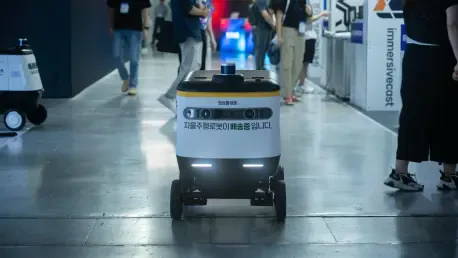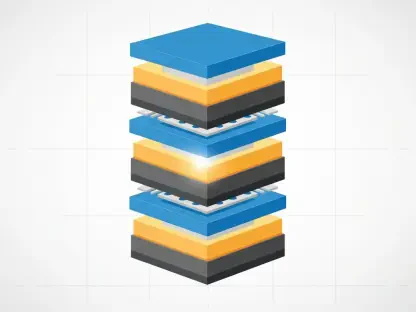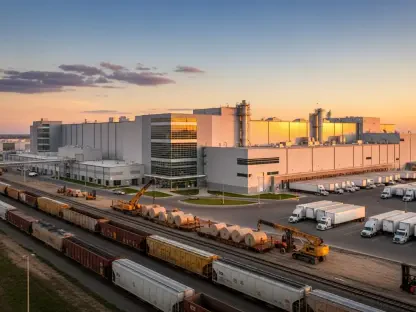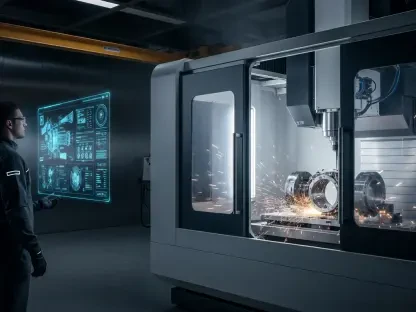In an era where the automotive industry is undergoing a seismic shift toward autonomy, Nvidia stands as a pivotal force driving this transformation with unparalleled technological prowess, reshaping the future of mobility. As vehicles evolve from traditional modes of transport into sophisticated, AI-powered machines, the challenge lies in creating systems that are not only intelligent but also safe and adaptable to diverse global markets. Nvidia has emerged as a leader in this space, crafting solutions that integrate cutting-edge hardware, innovative software, and advanced simulation tools to push the boundaries of what autonomous driving can achieve. Far from merely keeping pace with competitors like Tesla, Nvidia is setting a new standard by offering a comprehensive ecosystem that empowers automakers to navigate the complexities of autonomy. This approach is reshaping the industry, addressing technical hurdles, regulatory demands, and market-specific needs with a blend of flexibility and precision that promises to redefine mobility for years to come.
Revolutionizing Autonomy with a Full-Stack Ecosystem
Nvidia’s transformative impact on autonomous driving begins with its full-stack ecosystem, a robust framework designed to meet the diverse needs of automakers. The NVIDIA DRIVE AV platform lies at the heart of this system, offering a modular and scalable solution that spans from Level 2++ advanced driver assistance to Level 4 fully autonomous capabilities in specific scenarios. Powered by hardware like the DRIVE AGX Thor System-on-Chip, which delivers a staggering 1,000 tera operations per second for real-time sensor processing, this platform enables seamless integration of critical functions. Automakers can tailor features such as automated lane changes or active safety systems to their specific models while maintaining a clear path toward higher levels of automation. This adaptability ensures that manufacturers are not locked into a one-size-fits-all model, allowing them to innovate at their own pace while leveraging Nvidia’s cutting-edge technology to stay competitive in a rapidly evolving market.
Beyond the technical specifications, Nvidia’s ecosystem redefines collaboration within the automotive sector by prioritizing customization and scalability. Unlike rigid systems that dictate a singular approach, the DRIVE AV platform supports a spectrum of autonomy levels, making it accessible to manufacturers at various stages of development. This flexibility is complemented by software tools that allow for fine-tuning of features to align with brand-specific goals, whether enhancing driver assistance for consumer vehicles or pushing toward full autonomy for commercial fleets. Additionally, the integration of simulation environments ensures that automakers can test and refine their systems without the risks associated with real-world trials. By providing a comprehensive suite of tools that bridge hardware and software, Nvidia is not just supplying technology but fostering an environment where innovation can thrive, fundamentally altering how the industry approaches the journey to autonomous mobility.
Pioneering Safety Through Hybrid Data Strategies
A distinguishing factor in Nvidia’s approach to autonomous driving is its innovative hybrid data strategy, which balances real-world inputs with synthetic data generated through advanced simulations. Tools like NVIDIA Omniverse and Cosmos create virtual environments where rare and dangerous scenarios—often impossible to replicate safely in the real world—can be tested exhaustively. This method contrasts sharply with competitors who rely predominantly on data collected from extensive vehicle fleets on public roads. By simulating edge cases, Nvidia minimizes the risks and ethical concerns tied to real-world testing, ensuring that systems are robust before deployment. This strategy’s effectiveness was demonstrated at the CVPR Autonomous Driving Grand Challenge, where Nvidia’s Generalized Trajectory Scoring Method excelled in optimizing dynamic paths, underscoring the practical value of simulation-driven development.
The emphasis on synthetic data also addresses a critical gap in autonomous system training: the unpredictability of human behavior and environmental variables. While real-world data offers authenticity, it often lacks the breadth to cover every conceivable situation a vehicle might encounter. Nvidia’s simulations fill this void by crafting countless virtual scenarios, from adverse weather conditions to sudden pedestrian movements, allowing AI models to learn and adapt without endangering lives. This dual approach not only enhances the reliability of autonomous systems but also accelerates development timelines, as manufacturers can iterate rapidly in controlled settings. By blending the best of both data worlds, Nvidia ensures that its technology is not just reactive but anticipatory, capable of handling the complexities of real-world driving with a level of preparedness that sets a new benchmark for safety and performance in the industry.
Building Global Reach Through Strategic Alliances
Nvidia’s influence in the autonomous driving landscape extends far beyond technology, amplified by strategic partnerships with leading automakers and tech innovators across the globe. Collaborations with companies like Volvo, Mercedes-Benz, and Polestar integrate Nvidia’s DRIVE Orin and Thor platforms into next-generation vehicles, showcasing the trust placed in its solutions. In specialized sectors, firms like WeRide leverage the DRIVE AGX Thor for mass-produced Level 4 autonomous vehicles, while Aurora and Continental apply the same technology to driverless trucks. Particularly striking is Nvidia’s dominance in China, where it commands a 50% market share in advanced driver assistance systems and Navigate on Autopilot solutions, navigating geopolitical and regulatory challenges with remarkable agility. These alliances highlight how Nvidia’s adaptable framework meets diverse market needs effectively.
These partnerships are more than transactional; they represent a collaborative model that accelerates the adoption of autonomous technology worldwide. By aligning with established automakers and emerging players alike, Nvidia ensures that its platforms are tested and refined across a wide array of vehicle types and regulatory environments. This broad engagement fosters a feedback loop where real-world applications inform further innovation, creating a cycle of continuous improvement. Moreover, Nvidia’s ability to tailor its technology to regional demands—especially in markets with unique constraints—demonstrates a strategic foresight that competitors often lack. This global network not only solidifies Nvidia’s position as a leader but also drives the standardization of autonomous systems, paving the way for broader industry acceptance and implementation on an international scale.
Prioritizing Safety and Regulatory Compliance
Safety remains a cornerstone of Nvidia’s strategy, addressing one of the most significant barriers to widespread adoption of autonomous driving technology. The Halos safety system, a cohesive framework integrating hardware, software, and AI models, adheres to stringent ASIL B/D safety standards, ensuring reliability under rigorous conditions. This focus on compliance tackles the regulatory challenges that have slowed the global rollout of autonomous systems for other industry players. By embedding safety as a fundamental component rather than an afterthought, Nvidia builds trust with automakers who must navigate strict governmental oversight. This approach provides a distinct advantage in markets where safety certifications are non-negotiable, positioning Nvidia as a preferred partner for manufacturers prioritizing consumer confidence and legal adherence.
Furthermore, Nvidia’s commitment to safety extends into how it supports automakers in meeting evolving regulatory landscapes. As governments worldwide refine policies to address the ethical and practical implications of autonomous vehicles, compliance becomes a moving target that demands proactive solutions. Nvidia’s technology anticipates these shifts by offering scalable systems that can be updated to meet new standards without requiring complete overhauls. This forward-thinking design mitigates the risk of obsolescence and reduces costs for manufacturers, who can rely on Nvidia’s expertise to stay ahead of policy changes. By aligning technological innovation with regulatory foresight, Nvidia not only ensures safer roads but also fosters an environment where autonomy can be deployed responsibly, reinforcing its role as a trusted leader in shaping the future of transportation.
Contrasting Approaches in the Race to Autonomy
The competitive dynamics between Nvidia and Tesla reveal fundamentally different philosophies in the pursuit of autonomous driving. Tesla’s strength lies in its vertically integrated model, where in-house AI chip development and an extensive dataset from millions of vehicles fuel advancements in its Full Self-Driving system. This closed-loop approach allows for tight control over every aspect of development, optimizing performance through real-world insights. However, it can limit scalability and adaptability to diverse manufacturer needs. Nvidia, by contrast, champions a broader ecosystem built on partnerships with Tier 1 suppliers and automakers, offering flexibility that enables customized solutions. This open framework accommodates varying levels of autonomy and market requirements, making Nvidia’s technology more accessible to a wider range of players in the automotive space.
Interestingly, the lines between competition and collaboration are beginning to blur, hinting at a future where hybrid strategies may prevail. Speculation around Tesla potentially adopting Nvidia’s B200 GPUs for AI training suggests that even vertically integrated giants recognize the value of external expertise in specific domains. Nvidia’s ability to complement rather than replace existing systems positions it as a versatile ally, capable of enhancing rather than disrupting established workflows. This potential synergy underscores a broader industry trend toward integration, where combining strengths—be it Tesla’s data richness or Nvidia’s simulation prowess—could accelerate progress. As the race to autonomy intensifies, Nvidia’s collaborative ethos contrasts with Tesla’s insular focus, yet both approaches contribute uniquely to a landscape where innovation thrives through diversity of thought and execution.
Reflecting on a Legacy of Innovation
Looking back, Nvidia’s journey in autonomous driving reveals a remarkable shift in how the industry tackles the complexities of mobility. Its full-stack ecosystem, hybrid data strategies, and unwavering commitment to safety have redefined standards, setting a precedent that balances technological advancement with real-world applicability. Strategic alliances across continents demonstrate a knack for navigating diverse challenges, while the contrast with Tesla’s approach highlights the power of collaborative versus singular innovation. For stakeholders, the takeaway is clear: the path forward demands integration of diverse technologies and partnerships. Moving ahead, the focus should shift to scaling these solutions sustainably, ensuring that safety and compliance remain at the core. Exploring ways to bridge competitive divides through shared advancements could further unlock potential, shaping a future where autonomous driving becomes not just a possibility, but a trusted reality for all.









